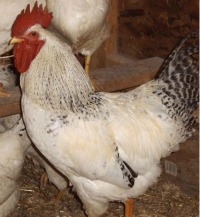Delaware Chickens: The Good Broiler Bird
Delaware chickens are excellent broilers for small scale meat production. They are very good for backyard chicken growers.
Delaware Facts:
Class: Standard: American Bantam: All Other Combs, Clean Legged
Size: Standard Male: 8.5 Ibs. / Standard Female: 6.5 Ibs. / Bantam Male: 34 oz. / Bantam Female: 30 oz.
Comb, Wattles & Earlobes: They have a moderately large single comb with five well-defined points. They have medium to moderately large wattles and elongated, oval earlobes. All of these are bright red.
Color: The beak is reddish horn and the eyes are reddish bay. They have yellow shanks and toes. The body and breast are white to silvery white and the hackle, tail, and wings are white with some black barring. All feathers have a white shaft and quill.
Place of Origin: United States
Conservation Status: Critical
Special Qualities: They make excellent broilers.

George Ellis was the originator of this breed. In 1940 he was using the usual cross of the day, breeding Barred Plymouth Rock roosters with New Hampshire hens, when he found one special group that seemed to do better than others. He continued breeding until he eventually developed this breed.
Normally this cross breeding produced birds that had hens who were barred and males who were either black or red. Ellis' breeding ended up producing a sport, or a distinctively different color than the norm. He also noted that these birds had excellent qualities for broiler production. Normally these anomalies end up fading and passing quickly. Ellis however, had a sported rooster in his flock that was a particularly rare specimen with excellent qualities all around. He nicknamed the rooster "Superman" and began breeding him with New Hampshire hens until the breed finally stabilized.
Delaware Chickens, in their prime, provided meat for most of the east coast. With the development of the Cornish cross it eventually lost it's luster and unfortunately today it is very rare. It is still regarded though as being an excellent dual purpose barnyard bird.
The breed can adapt to both free range or confinement and they are early to mature and hardy. The hens lay large, rich brown eggs and do tend to go broody.
They were first recognized by the APA in 1952.

Custom Search



New! Comments
Have your say about what you just read! Leave me a comment in the box below.